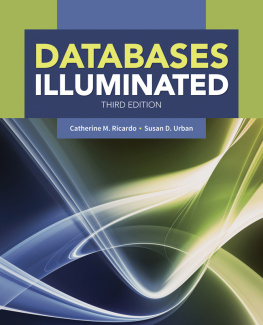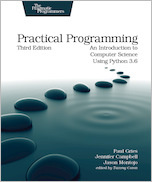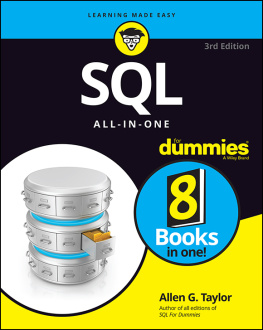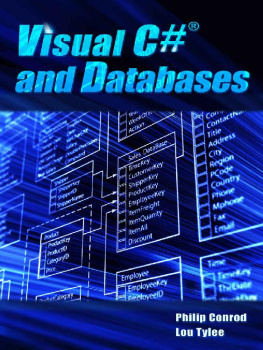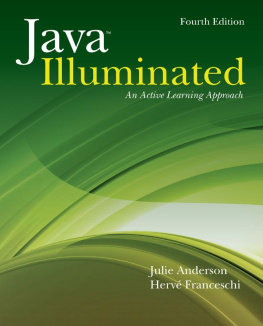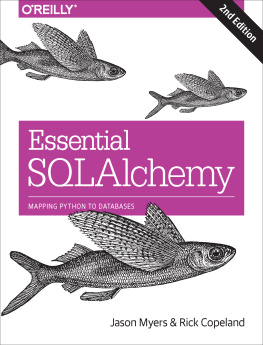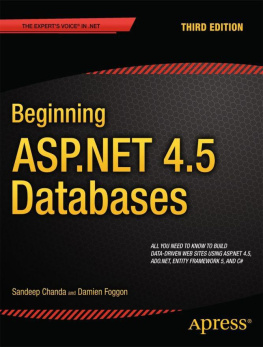Contents
Page List
Guide

DATABASES ILLUMINATED
THIRD EDITION
Catherine M. Ricardo
Iona College
Susan D. Urban
Arizona State University


World Headquarters
Jones & Bartlett Learning
5 Wall Street
Burlington, MA 01803
978-443-5000
www.jblearning.com
Jones & Bartlett Learning books and products are available through most bookstores and online booksellers. To contact Jones & Bartlett Learning directly, call 800-832-0034, fax 978-443-8000, or visit our website, www.jblearning.com.
Substantial discounts on bulk quantities of Jones & Bartlett Learning publications are available to corporations, professional associations, and other qualified organizations. For details and specific discount information, contact the special sales department at Jones & Bartlett Learning via the above contact information or send an email to .
Copyright 2017 by Jones & Bartlett Learning, LLC, an Ascend Learning Company
All rights reserved. No part of the material protected by this copyright may be reproduced or utilized in any form, electronic or mechanical, including photocopying, recording, or by any information storage and retrieval system, without written permission from the copyright owner.
The content, statements, views, and opinions herein are the sole expression of the respective authors and not that of Jones & Bartlett Learning, LLC. Reference herein to any specific commercial product, process, or service by trade name, trademark, manufacturer, or otherwise does not constitute or imply its endorsement or recommendation by Jones & Bartlett Learning, LLC and such reference shall not be used for advertising or product endorsement purposes. All trademarks displayed are the trademarks of the parties noted herein. Databases Illuminated, Third Edition is an independent publication and has not been authorized, sponsored, or otherwise approved by the owners of the trademarks or service marks referenced in this product.
There may be images in this book that feature models; these models do not necessarily endorse, represent, or participate in the activities represented in the images. Any screenshots in this product are for educational and instructive purposes only. Any individuals and scenarios featured in the case studies throughout this product may be real or fictitious, but are used for instructional purposes only.
07905-0
Production Credits
VP, Executive Publisher: David D. Cella
Publisher: Cathy L. Esperti
Acquisitions Editor: Laura Pagluica
Editorial Assistant: Taylor Ferracane
Director of Production: Amy Rose
Production Assistant: Anna Humphrey
Executive Marketing Manager: Andrea DeFronzo
VP, Manufacturing and Inventory Control: Therese Connell
Composition: Cenveo Publisher Services
Cover Design: Kristin E. Parker
Rights and Media Research Coordinator: Abigail Reip
Media Development Editor: Shannon Sheehan
Cover Image: Digital_Art/Shutterstock
Printing and Binding: Edwards Brothers Malloy
Cover Printing: Edwards Brothers Malloy
Library of Congress Cataloging-in-Publication Data
Ricardo, Catherine M.
Databases illuminated.Third edition / Catherine M. Ricardo, Iona College, New Rochelle, New York, Susan D. Urban, Arizona State University, Tempe, Arizona.
pages cm
Includes bibliographical references and index.
ISBN 978-1-284-05694-5 (casebound)
1. Database management. I. Urban, Susan D. II. Title.
QA76.9.D3R514 2017
005.74dc23
2015008322
6048
Printed in the United States of America
19 18 17 16 15 10 9 8 7 6 5 4 3 2 1
For Catherine M. Ricardo
To my husband, Henry J. Ricardo, my children Henry, Jr., Cathy, and Christine, and my grandchildren, Tomas, Nicholas, Christopher, Joshua, and Elizabeth.
For Susan D. Urban
To my husband, Joseph E. Urban. Thanks for all of your love and support.
Table of Contents
Preface
Purpose of This Book
Databases have become a central element of the framework of modern computer systems. So it follows that the study of database systems, design, and management is an essential part of the education of computer science and information science majors. A course in database technology should provide students with a strong theoretical background, practice in database design, and experience creating and developing a working database. Students should also be exposed to emerging data management issues and new directions for database technology. This book is designed to help students integrate theoretical material with practical knowledge, using an approach that applies theory to practical database implementation. This book will also help students understand the difference between traditional database technology and the new directions created by big data, outlining the motivation, fundamental concepts, technologies, and challenges associated with handling large datasets.
Structure
Theoretical foundations are presented early, and the concepts reappear throughout the book, including in the chapters that address implementation. Logical database design is given full consideration. The entity-relationship (E-R) model is introduced early and then mapped to the relational model. Relational normalization is studied in detail, and many examples of the normalization process are discussed. The object-oriented model is presented using Unified Modeling Language (UML) as a vehicle for logical design. The enhanced entity-relationship (EE-R) model is presented and then mapped to both relational and object-relational models. Extensible Markup Language (XML) and the semi-structured data model are also introduced.
A continuing example of a university database is incorporated throughout the text, to illustrate concepts and techniques and to provide both continuity and contrast. Other examples are presented as needed. Purely relational, object-relational, and object-oriented database systems are described and used for implementation of the examples. Details of database management systems are explored so that students can learn the specifics of these real-life systems down to the level of physical implementation. LibreOffice Base is used initially in the examples, but Oracle is introduced as the material is developed. The examples are suitable, however, for use with any relational or object-relational database management system (DBMS). The InterSystems Cach DBMS is used to illustrate object-oriented databases.
The fundamentals of storing and accessing large data sets are introduced using Hadoop and its two main components: the Hadoop distributed file system and the MapReduce parallel programming paradigm. The Hive data warehouse infrastructure of the Hadoop environment is examined as a means for expressing Structured Query Language (SQL)-like queries over large files. HBase is also examined as a column-oriented approach to the scalable, distributed storage of large tables. The IBM BigInsights Quick Start Edition Console is used for all examples of big data in the book. NoSQL and NewSQL are also addressed as variations of big data technology.
New to This Edition
New chapter on the emerging topics of big data, NoSQL, and NewSQL
Coverage of Apache Hadoop, Hive, and HBase, with accessible examples of each

